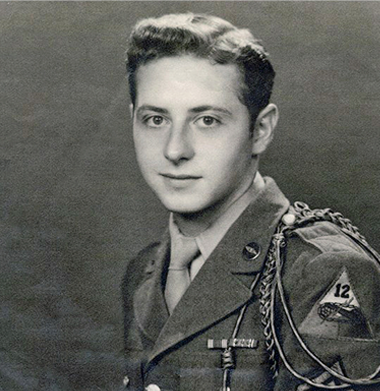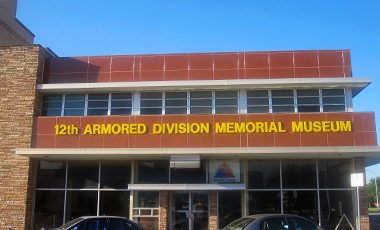
The 12th Armored Division Museum
Goop salutes the role our founder, John Critzas, took as part of the 12th Armored Division under General George Patton. It is our honor to share with you more of their history, in conjunction with the 12th Armored Division Museum.
We recommend that you visit the 12th Armored Division Museum site to learn more about John and other American WWII heroes. Also, visit the 12th Armored Division Facebook page for current information and events.
About the Armored Division
Armored Divisions were first developed and used during WWII. They included all 3 major combat arms branches of the Army- Infantry, Tank, and Artillery battalions. Armored Divisions also included support units such as Medical, Signals, Engineer, and Ordnance battalions. All units were mechanized- meaning that all men rode in vehicles- so that the entire Division could move at the same pace. The Division consisted of:
- 3 battalions of Armored Field Artillery. Self-propelled 105mm howitzers called the M7 “Priest.” These battalions enabled American forces to lay down a large quantity of highly accurate, destructive power from a safe distance.
- 3 battalions of Medium Tanks, the M4A1 Sherman. Tank battalions were instrumental in providing highly mobile firepower in battle.
- 3 battalions of Armored Infantry. The Armored Infantry traveled in armored half-tracks, allowing them to travel faster than conventional infantry.
- Support Units: Medical, Engineers, Ordnance, Signal Corps, Anti-Aircraft Artillery, and Headquarters.


Training and Campaigns
- Fort Campbell, Kentucky, is where the 12th Armored Division was formed on September 15th, 1942. This is where most of the men received their basic training.
- Tennessee Maneuvers was the field test to see if the men were combat-ready.
- The division then moved to Camp Barkeley in Abilene, Texas in 1943, where the men of the 12th received their specialized training on weapons, equipment, and vehicles.
- Camp Shanks, New York, 1944.
- Arrived in Liverpool England, on October 2, 1944, and billeted at Tidworth Barracks.
- Crossed the English Channel to La Havre, France on 9 November 1944.
- Billeted at Auffay, France, 17 November 1944. Final equipment received and ordered to Luneville on 2 December, 1944.
- First shot fired in combat by the 493rd Armored Field Artillery on December 5, 1944, in Weslingen, France.
- Stopped Hitler’s last offensive west of the Rhine at Herrilsheim, France. The battle lasted from January 6th – 20th 1945. Lost two-thirds of its combat strength in the battle, earning the nickname ‘Suicide Division’ from its German foes.
- Served under command of the French First Army in the Colmar Pocket operation, 3 February 1945.
- Attached to Patton’s Third Army for the Race to the Rhine River on March 17, 1945. Earned its nickname ‘The Mystery Division’ because men removed all unit insignia from vehicles and uniforms for security reasons.
- Fighting through Germany.
- Captured an intact heavy bridge across the Danube River at Dillingen on April 22, 1945, greatly speeding the Allied advance.
- Liberated Concentration Camps in Landsberg, Germany, on 25 April, 1945.
- Participated in the last battle of the war in Europe, starting on VE Day (8 May 1945) at the Itter Castle in Austria. To prevent numerically superior SS forces from capturing and executing French political prisoners being held at the castle, officers of the 12th Armored Division re-armed captured German Wehrmacht (Regular Army) soldiers and fought side by side with their prior enemies.
Liberating Concentration Camps
The 12th Armored Division captured an intact bridge at Dillingen on April 22nd, 1945. This allowed Allied forces to cross the Danube River into Southern Germany. The 12th Armored Division is officially credited with the liberation of Hurlach 4 outside of Landsberg, Germany. The camp was in the process of being destroyed by the SS; inmates of the camp had been locked into their hovels, and the hovels were set on fire. Within the 12th Armored Division Memorial Museum Archives, there are accounts of many other camps being liberated.
The 12th Armored Division Museum – A Unique World War II Museum
The 12th Armored Division Memorial Museum holds a rare place among military museums. Our visitors, who tour military museums throughout the United States and Europe, tell us we are the only one dedicated to telling the story of one unit’s combat history in WWII. The museum uses three floors of exhibits to tell the story of the 12th Armored Division.
This museum fills a void in the history of the war in Europe through the use of the photographs, artifacts, and personal testimonies of the veterans of the 12th Armored Division. It tells the individual stories and the roles of individual soldiers in winning the battles in France and Germany. The majority of WWII military museums display military hardware and uniforms. They may have a video or two about D-Day or other major battles, but they don’t tell their stories from the perspective of the guys who were on the ground. Our photographs show what life was like for members of the US Army during WWII and make our presentation much more personal than the typical military museum exhibit. A visitor, who is associated with an army museum in Florida, told us this museum presents important aspects of the history of WWII through its manuscripts, photographs, and oral histories. He commented that most museums do not have these items on display.
We tell the personal stories of the men who liberated a concentration camp, what they saw and how it affected their lives. From their testimony, we are able to tell about the Holocaust from a unique perspective. Each year, the eighth-grade students from the Abilene Middle Schools visit the museum to learn about the Holocaust, its causes, and effects. The museum received a RUS Distance Learning Grant from the USDA in 2011. This grant provided the equipment needed for the museum staff to provide teleconference/webinar-type live programs about the Holocaust and WWII to students anywhere in the country. We are an educational museum as well as a memorial museum to the men of the 12th Armored Division.
The museum has a seven-part diorama that presents a three-dimensional view of the battles at Herrlisheim, France, in January 1945. This professional display depicts the conditions the men of this division encountered as they fought the German Army during the Nordwind Offensive, in which the German High Command hoped to recapture Strassburg and the fuel, food, and munitions they so desperately needed to continue the war. The actions of the 12th Armored Division to force the German forces back across the Rhine River definitely shortened the war in Europe, and only this museum tells that vital part of the history of WWII.
Museum Information
LOCATION
1289 N 2nd Street
Abilene, TX 79601
PHONE
325-677-6515
MUSEUM HOURS
Tuesday – Saturday
10 am – 5 pm
ADMISSION
Adults $5
Senior/Military/ Student $4
Child 7-12 $2
Children 6 and under are Free
WWII Veterans Free
Group rates and guided tours are available upon request
Oral History
The 12th Armored Division Memorial Museum houses over 300 oral histories. You can find John Critzas’ oral history along with the others at the Oral History page on www.12tharmoreddivisionmuseum.com
Education and Research at the Museum
- The museum offers “in-house” educational tours tailored for any grade level.
- The museum also houses a Distance Learning Lab and can teach live to schools anywhere in the world.
- Topics include: How the Allies Won, Holocaust, and Societal Changes after WWII.
- The museum offers its archives and library to researchers.
- Call Jennifer Lenches at the museum for details and arrangements.

